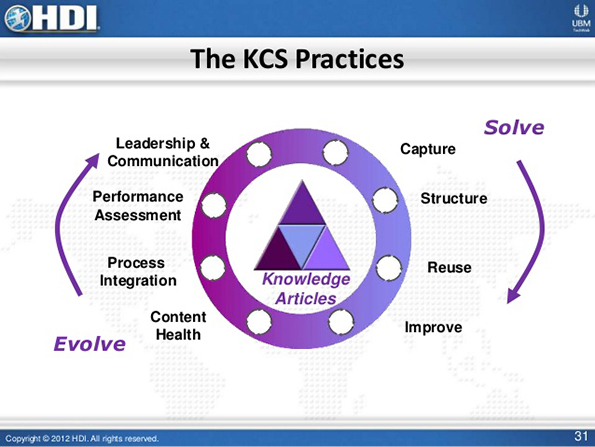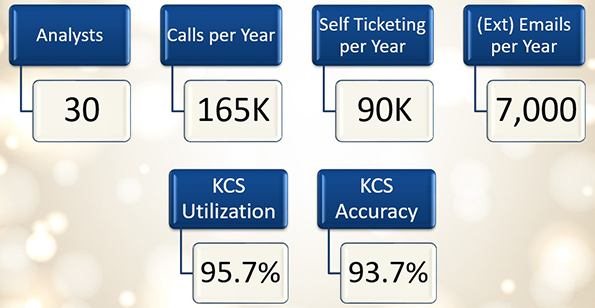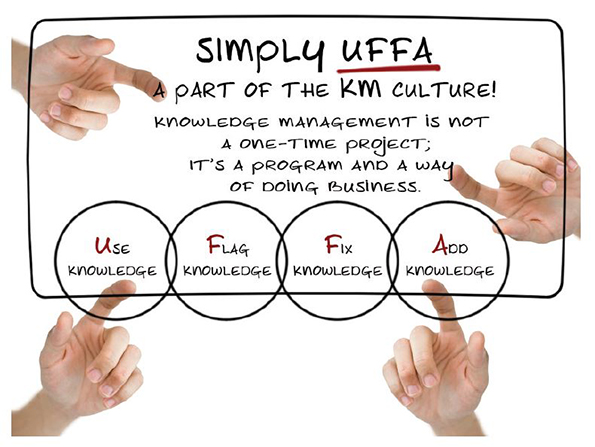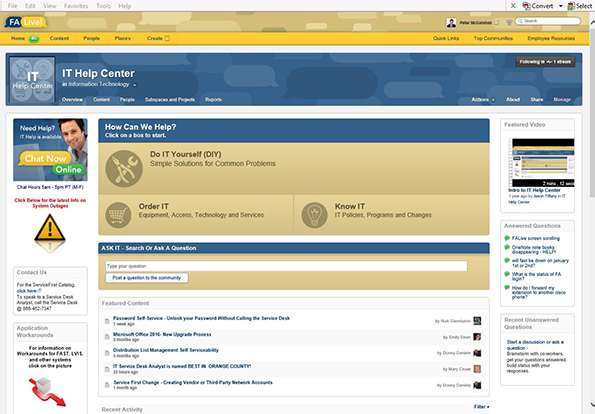Date Published December 15, 2016 - Last Updated July 19, 2018
When I first arrived at First American (FA), we began our Knowledge Management (KM) discussion in terms of who would use knowledge and when we would use knowledge and for what purpose. The bigger question was really how we would use knowledge to better support our customers and how we would know we achieved that goal (success measures).
This necessary but tiring discussion led me to realize that there was some resistance and hesitance to implementing KM. I challenged my leadership team to adopt a perspective where knowledge was not an option but a core part of our team’s job responsibilities, to reconsider their viewpoint that KM was a choice versus a mandatory requirement for continuous improvement and sustainable success.
Knowledge was not an option but a core part of our team’s job responsibilities.

I believed KM was a daily operational practice that would integrate into how the service desk would perform incident and request management. Our RightAnswers solution, integrated into our hosted ServiceNow solution, along with best practice processes and training would measure a noticeable customer service differentiator. When we did knowledge right, it would serve as a game changer in terms of quality, speed, and customer satisfaction and prepare us for future opportunities in supporting our business. At a high-level, we would need to accomplish three very important goals in order to have a sustainable and successful KM program:
- Integrate KM into the ITIL incident management process workflow
- Implement content authoring and quality management practices and discipline
- Introduce and operationalize the Knowledge Centered Services (KCS) practice of Using, Flagging, Fixing, and Adding (UFFA) knowledge articles (KAs) into our “single source of truth”
In Pursuit of Knowledge
Utilizing KM in operational practice is very different than the theoretical KM documentation. We needed guidance and help in better understanding what was important, foundational, and sequential in our soon to be KM journey. We learned about Knowledge Centered Services (KCS) and quickly adopted the KCS curriculum and certification founded by the Consortium for Service Innovation and delivered by HDI. KCS is a simple idea that speaks to integrating the creation and maintenance of knowledge into the process of interacting with the customer. To be successful in this pursuit of continually improving operational efficiency and always learning, we knew we needed to change the way we thought about our people, processes, measurements, and what sustained success looked like (measures). We got the leadership team serious about creating a culture of knowledge. We sent our senior leadership team to KCS Certification training and then, soon after, we sent all of our managers, team leads, and star performers. The team leads and star performers eventually became our KCS coaches and spread the culture of knowledge to the team who applied it on a day-to-day basis.
Get your service management content in person at Service Management World!
Join us!
Foundational Knowledge
At First American, we have been practicing KCS for over four years, and we’ve seen increased adoption, engagement, and results. Making KM operational and a core part of our incident and request process, holding our team accountable for the regular UFFA practice of KM, and integrating KM into our ITSM tool were critical success factors early on that positively influenced our journey. UFFA became an integral part of our IT vocabulary, and we reminded our team daily to make it operational:
- Search ALL THE TIME and EVERYTIME for knowledge, and if they found it and it worked, then use it.
- If they found it and it was incorrect or outdated, flag it to be sent to the content author (CA) for fixing and return corrected/updated to the knowledge base (KB).
- If they searched and did not find a KA, flag it to be added to the list of relevant KAs needing authoring and review before being added to the KB.
Another early influential decision was to exclude policies, processes, and procedures (e.g., Run Books, SOPs, etc.) in our KB. Our intent was not to clutter the KB with documents not specifically created with the purpose of resolving, fulfilling, answering, or providing a customer with a workaround. Our intent was not to create a KB focused on the quantity of documents, but rather quality, purposeful, and relevant KAs used for assisting customers with issues, questions, or requests.

We used a SharePoint repository for the procedural documents. If there was information in these procedural documents that enabled the service and support teams (L1, L2, and L3) or the customer (L0) to resolve the issue, fulfill the request, answer a question, or provide a temporary workaround, we would create a KA with a hyperlink to that relevant section within the procedural document stored in the SharePoint repository. It was critical for our Tier-2 and Tier-3 assignment groups authoring knowledge to know our intent was to always search the KB and find and use their KA to resolve an issue, fulfill a service request, or correctly answer a question on first contact. We also regularly reported to them on usage of their team-authored KAs in terms of First Contact Resolution (FCR) and NO assignment to their team (i.e., One & Done).
A Knowledge-Enabled Service Strategy
Our shift-left service strategy to move resolution closer to the customer in a multi-tiered support structure was clearly dependent on being successful with our KM strategy. The maturity and derived business value of KM lies in our ability to create and utilize the “single source of truth.” This single source of truth is solely dependent on our discipline for creating quality, relevant KAs addressing why customers contact the FA service desk. The service desk and desktop services staff handle, resolve, and fulfill about 80% of all incidents and service requests. To challenge ourselves, we would routinely ask staff their confidence level in searching the KB and also finding the KA to accurately resolve the issue, request, or question.
Of course, we were looking for a positive response, that they felt confident that searching the KB all the time saves time and provides them with the EXACT information they need to resolve, fulfill, or answer to the customer’s satisfaction.
The Single Point of Contact Accountability
Our single point of contact (SPOC) service desk is accountable for all the knowledge used to solve technical issues and problems, answer how-to questions, and fulfill standard service requests. The service desk leadership works with the Tier 2 and Tier 3 IT technical staff (Gurus, SMEs) and the business groups (Champions, Business Analysts) to document the knowledge (solutions, processes) required by all levels of the tiered support model. The service desk analysts rely on the Tier 2 and Tier 3 subject matter experts (SMEs) to document and share their expertise around resolving issues. There are control processes for promoting new knowledge to production and who will have access to that knowledge, but adding knowledge is encouraged at all times and not interrupted by the quality control process. The service desk and desktop services teams, along with the technical and business SMEs, work together to keep the “single source of truth” populated with knowledge that is both relevant and accurate. This means that when employees have a need for it, they find it, use it, and get the results they were expecting. This result continues to build the team member confidence in the KB, encouraging them to search all the time.
Building the KM Team
When implementing the KM program, we engaged the most positive and influential team members first. We selected them to be knowledge coaches and evangelists, promoting all the wonderful aspects of our KM program. We were careful not to select team members with the most knowledge, seniority, or expertise. In the end, this was one of the most long-term impactful decisions we made. These KM coaches were impressive during this effort and took accountability and ownership within their team to influence (bottom-up), putting knowledge at the high-end of the value-chain. The coaches were a key factor in the successful adoption of our KM program. These influential knowledge coaches impacted our culture of knowledge early on, and It’s hard to imagine where the program would have ended-up if we did not empower and train them at the beginning of our journey.

Example: In 2015 we created 1,529 Knowledge Articles where Service Desk and Desktop teams equally combined to create 95% and we used 25,000 Knowledge Articles throughout the year utilizing KCS 95.7% of the time to a 93.7% accuracy.
Currently over 90% of our cases are closed using KAs. Additionally, many of the original knowledge coaches have been promoted or have accepted other positions due to their leadership and exposure received in their contributing role to our knowledge success. Our step-by-step process followed these critical steps in our knowledge maturity:
- Knowledge champions and coaches were selected and KCS trained and certified and passionately pursued the path of finding, documenting, and sharing all the relevant information in template KA format. They were recognized and rewarded for their effort in populating the KB. Knowledge was always a topic of discussion at all team and one-on-one meetings.
- All service desk and desktop team members began KCS training on the operational and expected use of knowledge.
- The team gained unequivocal understanding of the knowledge policy, procedures, style guide, and KCS writing methodology utilizing our First American KA template.
- With expired KA, our KCS coaches will validate and extend if the solution is still relevant or flag and archive an article and, depending on content, check to see if it is seasonal and whether it could be used again in the future.
- On quality assurance scoring, we would conduct regular calibration meetings to ensure all coaches work together to make sure they score the service desk consistently in terms of their daily use of knowledge.
- The team would proactively and continually seek out opportunities, events, and situations where knowledge could and should be utilized and adopted to support successful outcomes. Additionally, they would promote the value of our KM program to our customers, peer groups, and stakeholders to gain company awareness, support, and participation.
- Introduced a gamification-style hierarchy of achievement and contribution levels as a reward and recognition program. These various levels recognize the contributor’s reputation for posting high quality and relevant content based on a point scale connected to quality, relevancy, and quantity.
Delivering Knowledge “At the Speed of Conversation”
All of our team plays an active and operational role in KM. We simply stated that to deliver knowledge “at the speed of conversation,” facilitating FCR, our knowledge needed to be easily searched, retrieved, relevant, useful, and accurate. The incident and request management process, integrated into our ServiceNow tool, makes it easier to flag knowledge for fixing. It also makes it easier to add new information when the knowledge is absent and encourages assignment to other technical and business analyst groups.

Knowledge articles successfully utilized on the frontline resolving issues, answering questions, and fulfilling requests on first contact are prime candidates for deflection to our FALive IT Help Center for customers. These “Knowledge Nuggets” have multiple formats (documents, video, audio, scripts, etc.) and typically involve a standard IT service offering (hardware, software, systems, applications, mobile devices). The use of these KAs can be tracked to the actual customer contact and the ServiceNow ticket created by the service desk handling the phone calls, emails, chats, and walk-ups. Authored predominately by IT, customers have comfort and confidence that these KAs are 100% accurate due to the rigor of the knowledge management approval process.
We have worked hard to increase our FCR, reduce the reopening of issues not successfully resolved at first contact, reduce the backlog of assigned issues (SLA violations), and reduce the wait and resolution times (MTTR), while reducing the total cost of support and increasing customer satisfaction (CSI). This demonstrates a positive ripple effect from the diligent and consistent efforts of Using, Flagging, Fixing and Adding knowledge.
The Self-Service Imperative
We worked diligently on designing, building and populating the self-service portal we call the FALive IT Help Center. We divided it into three separate sections: Do It Yourself (DIY), Order IT, and Know IT. We also added Ask IT, Click to Chat functionality, and a System Outages Alert Page.

We patiently worked with many customer groups, including our marketing department, to ensure that the portal was easy to access, navigate, and use. Improving the ease and effectiveness of searching has benefited all self-service users, especially during busy days (e.g., Mondays) or when there is a P1/P2 system outage that typically generates a substantial volume of calls all at the same time creating a call volume spike. This event increases wait time and abandons and frustrates customers on hold wanting answers. We introduced our Self-Service FALive IT Help Center Alert Page in addition to quickly recording and posting emergency outage greetings (P1/P2) that continues to play to customers already on-hold.
This approach has helped us to build trust and confidence and set our customer’s expectations accordingly in terms of providing regular status updates that keep them informed of the timing around their resolution, a workaround, or next steps. Customers can also easily enter a child ticket themselves under the already created master ticket so we can measure the impact of the P1 or P2 on our customer base. This also allows us to send them status updates and an issue resolution email when the issue is resolved and closed.
We are continually focused on self-service success as measured by adoption, the customer experience, and their success rate. We make sure that our marketing messages for increasing awareness and adoption are based on customer-centric benefits, not what’s in it for us.
I want to thank my First American leadership team, Mary Cruse, Brandon Caudle, Brad Biagi, Fahim Karin, Wade Pusch, David Carlson, Jim Brewer, our KCS Coaches, Team Leads, Team Members, HDI, RightAnswers, and our ServiceNow Process Automation team who have committed themselves to the KCS practice and making a noticeable difference every day for our customers. It is because of their hard work and dedicated focus that the First American service desk has been asked to launch a customer support team, providing service and support to First American customers utilizing their services and solutions. It is a great honor to be entrusted to serve our company’s customer base as well its most valuable assets, its employees.
Peter McGarahan is senior director of IT for First American Financial. Pete received the 2015 First American Excellence Award in IT, continuing his role as an industry thought leader and expert in the field of IT Service Management. He is also the founder of McGarahan & Associates and offers 30 years of business, IT, and service leadership. Pete has received HDI’s Team Excellence Award for his work with the Taco Bell support organization, the “Top 25 Professionals in the Service and Support Industry” from IT Support News, and the “Legend of the Year” (twice) at the HDI Conference for his endless energy, mentoring, coaching, and contributions to the service and support industry and community. You can reach Pete by email, follow him on Twitter, and connect with him on LinkedIn.